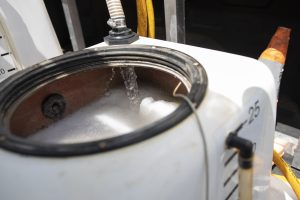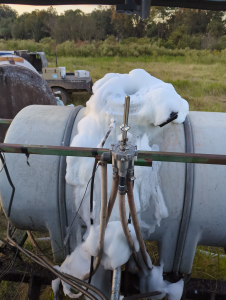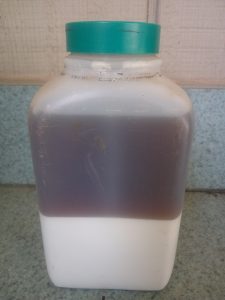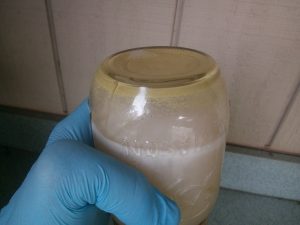
Peanut butter and jelly, milk and cookies, Marky Mark and the Funky Bunch, combinations can create magic. Beyond delicious treats and sick beats, we do combinations in the pesticide world as well. Tank mixing is a common practice but must be well thought out. So come learn to be a Mixologist: How to Properly Tank Mix.
There are many reasons you might combine more than one pesticide in a tank. Here are some of the benefits of tank mixing:
- Better pest control
- More species controlled (broad spectrum)
- Increase in efficacy (fewer treatments needed)
In some crops if every pesticide used went out as in individual treatment farmers might never be done treating! Instead of driving the same field over and over like some bad Groundhog Day movie, one pass may do the trick. It’s not just pesticides that can be mixed, fertilizers can be used as well to help feed the crop, while killing the pests. This is why tank mixing is so common in agriculture (although other pesticide users might tank mix as well, its just not as common). With all the advantages surely, there is a cautionary tale or downside, why else would I have a blog! Keep reading to find out about the risks to tank mixing and how to do so properly.
Incompatibility
Toothpaste and orange juice, mustard and peanut butter (my father eats this, yuck!), Michael Jackson and Eddie Murphy (no, for real), not all things should be combined! There are several key types of incompatibility and a few other considerations to put in place before tank mixing
Legal
Not every pesticide can be combined with each other, and some pesticides can’t ever be combined. As with all things pesticides READ THE LABEL. Many products will restrict certain combinations or ban mixing all together. However, FIFRA Section 2 (ee) clearly states that unless a label explicitly bans mixing, it is legal to mix various pesticides together, so long as you can follow ALL label instructions on ALL products. So, if one product tells you to use only 20 gallons of diluent per acre and the other says you must use 50…you can’t mix these. Furthermore, as endangered species rules and PULA’s show up on more labels you must be compliant with them as well. So read and follow ALL label instructions as it relates to the use of pesticides.

Chemical
Some products simply won’t mix well because they will bind to each other, or otherwise make the pesticides inactive. This can come from the products themselves or even the carrier you are mixing your product in. If the water has lots of charged particles, that could bind to the pesticide and keep it from working. Think of magnets with opposite charges…they stick together. This type of incompatibility can be hard to detect by visual clues alone but might involve the solution getting really hot. Clearly this is not ideal.
Physical
This is the most obvious incompatibility, and the one people most often think of. This could cause the mix to form a paste, a solid, separate into layers. Basically, the products refuse to mix equally, which can be a big problem. The product could fail, damage your equipment, or even become a solid block stuck in the tank. Product that doesn’t mix or layers will not spray equally across your target site. Not good.


What to do?
Pesticide labels will typically list known incompatibilities. The other thing you can do is a jar test and a small field test. For a jar test you essentially mix the pesticides you want to put in your tank into a jar and mix them there. That way you can see any clumping, layering, or other indicators of incompatibility. A small field test means testing a new combination in a very small area to test efficacy, selectivity, and any other observable issues that might come up.
Mix your ingredients at the concentration you spray, shake the jar, and wait. Then after 15-30 minutes shake the jar again and wait. There are also online tools and apps for the phone that can help find known incompatibility issues. The most widely used is Mix Tank, by Precision Laboratories (http://www.mixtankapp.com/).

Mix Order
Another helpful way to avoid trouble is to make sure you mix in the proper order and in the proper way. The first key is to always fill your tank half full of your carrier (like water) and start agitating and keep agitating as you add products. Once you have a carrier half full and you are agitating add products in the APPLES order:
A. Ammonium Sulfate, acidifiers, other tank conditioning agents
P. Powder solubles (dry fertilizers, soluble granules (SG), soluble powder (P)
P. Powder dry (dry flowables (DF), water dispersible granules (WDG), wettable powders (WP), water soluble packs (WSP)
L. Liquid flowables (flowables (F), micro-encapsulated products (ME), soluble concentrates (SC)
E. Emulsified products (emsulsifiable concentrate (EC), oil-in water emulsions (EW), oil dispersion (OD)
S. Solutions (solutions (S), Soluble liquids (SL)
Once all pesticide products are added you would put in any other adjuvants or surfactants like stickers, spreaders, drift agents. Finally keep agitating and add the remaining carrier (water) to the tank. Agitate throughout the application process to ensure products don’t separate overtime.
There you have it combinations can make life easier but only if they are done properly. So be sure to follow all label instructions, perform a jar test for new combinations, spot test new combos, use the tank mix app and follow APPLES. If you do this, you will be an expert pesticide Mixologist and know How to Properly Tank Mix.
Click to Subscribe
 4
4
